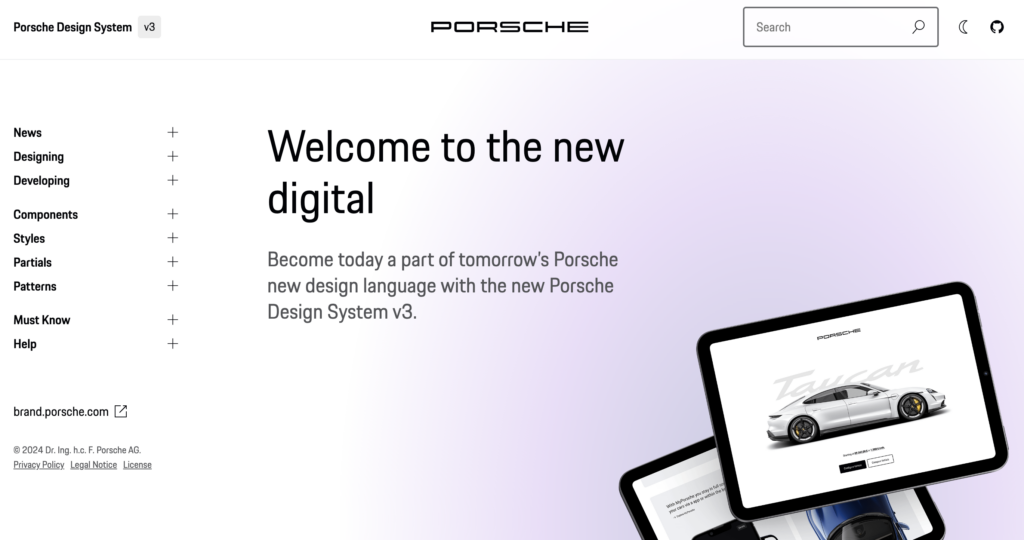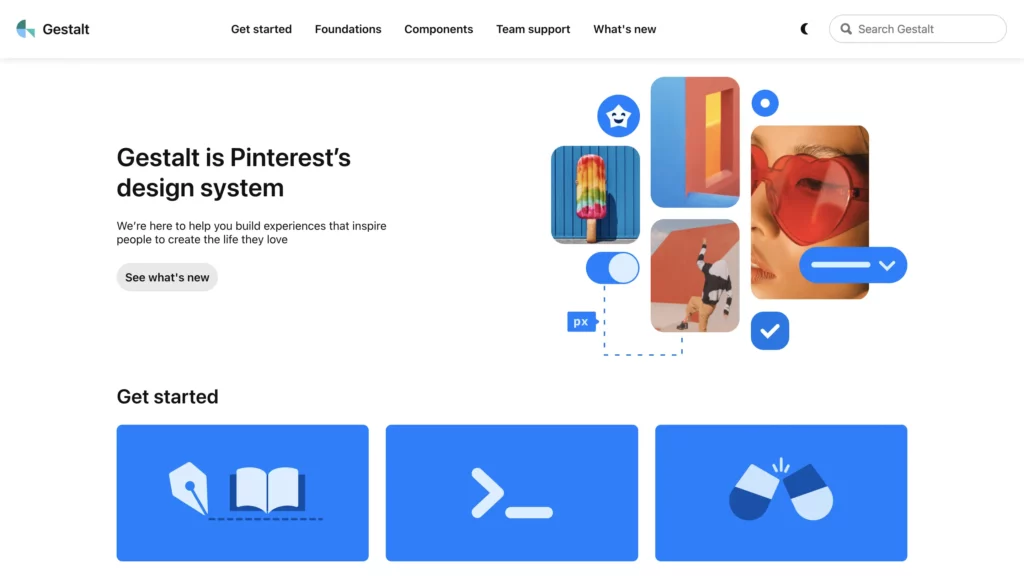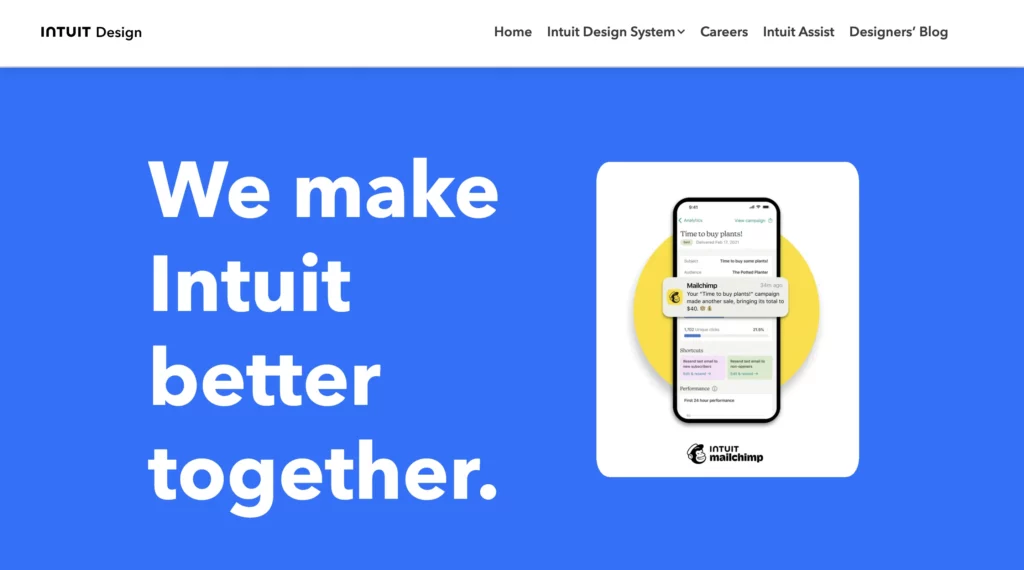13 Best Design System Examples in 2025

Looking for a clear design system definition and proven patterns? Start here – then dive into 13 design system examples with features, links, and takeaways.
Design system is a set of components, rules, style guides, and documentation used to build a coherent and on-brand interface of a product. Most brands create their own design system and we prepared a list of thirteen most popular design systems that you can learn a lot from.
What is a Design System?
A design system is a collection of all design resources that a product team may use to build user interface of their app, website, eCommerce store or any other UI design they need to develop.
Design systems aren’t only for designers. They are also for developers, as they contain all code snippets and development resources with necessary front-end code together with documentation as well as design guidelines, relevant plugins, design patterns, style guides, reusable components, rules plus guidelines, and all other building blocks useful for web design and development workflow.

These design systems are then hosted as websites online and can be publicly available (they are open-source design systems) or internal, whatever the brand decides.
We can think of a design system as a vast data library that acts as a valuable document with applicable instructions and examples, product design and coding guidelines, and a part of the UI kit all at the same time.
As you can see, there are many product design concepts related to design systems. If you want to learn to differentiate design systems from pattern libraries, component libraries, and UI kits, read our previous article on the topic: The difference between design system, pattern libraries, style guides, and component libraries.
Design System vs. Pattern Library vs. Style Guide (Quick refresher)
-
Design system: The full stack—principles, design tokens, components, patterns, code, accessibility, governance, and contribution model.
-
Pattern library: Reusable UI patterns and usage guidance. Often part of, not a substitute for, a design system.
-
Style guide: Brand and visual language (logo, color, type, tone). Supports a system but doesn’t cover components/code.
-
Why it matters: Teams search for different terms. Clarifying scope helps adoption and sets realistic expectations.
Why Are Companies Building Unique Design Systems?
Companies like Shopify, Google, AirBnB, and other are building their own unique design systems because they want:
- Consistency – design systems act as a single source of truth for design and development.
- Transparency – developers can use the design system components directly, without needing to interpret design decisions.
- Scale – designers are able to build prototypes faster and streamline developer handoff.
- Reusability – design systems facilitate the creation of prototypes with consistent components that can be shared within the organization.
- Clarity – design systems help ensure that design decisions are based on shared knowledge, making it easier for team members to understand and contribute effectively.
What is There to Learn from Design Systems?
The majority of design systems follow rather general setup patterns.
The system often features its top navigation with the main categories: Design, Code, Language, Components, etc.
Each of these main categories has its subcategories that discuss things in more detail, making the most out of the atomic design structure. For instance, these subcategories could be something like Typography, Color, Forms, Banners, etc.
Following this intuitive navigation can get you valuable information about best practices in terms of design.
As your product and team scale, a design system streamlines delivery through shared tokens, accessible components, and clear governance – reducing rework while improving quality.
The Benefits of Creating a Design System
With a well-built design system in place, businesses can considerably improve their teamwork and streamline decision-making process, but that’s not all that you can get from creating a design system.
Such collection of guidelines, elements, and data minimizes communication issues between designers and developers and minimizes the room for potential UX design bugs or acquiring UX debt.
What’s more, having such a reference-rich library significantly reduces the necessary time to go from a prototype to an actual product.
For example, PayPal uses Fluent UI together with Merge technology. This allows them to incorporate the interactive components to the UXPin library. That way, both designers and product team members alike can easily access these components and design with them over and over again.
Design systems are a great way to minimize the disconnect between designers and developers but are still not the ideal solution on their own. Thanks to the Merge technology revolution, product team members can easily use the same tools and improve their DesignOps workflow processes. This means that both developers and designers can access and use the same UI elements from one single source.
If you ever lose your important design assets or files during this process, tools like Photo Recovery Software can help you recover deleted or lost images, design screenshots, and other valuable visuals essential to your design system documentation.
How to Evaluate a Design System (checklist)
-
Coverage: Core foundations (color/type/spacing tokens), component library, and common patterns.
-
Documentation clarity: Purpose, usage, do/don’t examples, and platform notes (web, iOS, Android).
-
Accessibility: WCAG mapping, keyboard behavior, focus states, color contrast guidance, and testing notes.
-
Code + delivery: Install instructions, package names, frameworks supported, versioning, and changelog.
-
Theming & tokens: Clear token names, scales, and how tokens map to components and themes.
-
Governance: Roles, decision-making, backlog, and release cadence.
-
Contribution model: How to propose changes, review criteria, and acceptance timelines.
-
Adoption proof: Real examples, screenshots, or references from shipped products.
Design System Challenges and Solution
Even when companies try to create their design system, specific issues and consistency disconnects can still happen, especially when maintaining all the elements, documentation and code.
Learn more about design system challenges and solutions from one of the top design leaders – Johnson & Johnson. During our webinar, the J&J team shared all their best practices.
13 Real-world Design System Examples
Example 1: Porsche Design System

The Porsche Design System is an exemplary model due to its comprehensive, well-documented, and high-standard approach to design and implementation, making it a valuable reference for anyone looking to create top-tier web applications.
The Porsche Design System stands out because it provides the essential design fundamentals and elements required for creating visually appealing and high-quality web applications. One of its key strengths lies in its pixel-based libraries for Figma and then coded ones in UXPin, which streamline the design process for digital creators. Additionally, it includes coded Web Components and detailed usage guidelines, ensuring that the implementation is as smooth and consistent as the design.
What truly sets this system apart is its adherence to the rigorous Porsche quality standards and corporate design principles. Every component is meticulously built and tested, guaranteeing not only aesthetic excellence but also functional reliability. This holistic approach ensures that the final products are both beautiful and robust, reflecting the esteemed Porsche brand.
What to copy: consistent web components, detailed usage guidance, and quality gates that mirror brand standards.
Example 2: Google Material Design System
One of the most popular design system is Google’s Material Design. Google created and publicly shared their Material Design System that goes into the tiniest details regarding everything there is to know about the design and design principles. Every UXPin user can easily use the Material Design components as they are one of the UXPin libraries.
Thanks to this system, users can get valuable information that perfectly unifies UI and UX across different devices, platforms and input methods.
Material Design allows other brands and individuals to have a strong foundation for building upon when it comes to their own approach to atomic design, industry innovation and unique brand expression.
The main features of the Google Material Design System include:
- Starter Kits
- Design Source Files
- Material Theming
- Layout
- Typography
- Color
- Components
- Mobile Guidelines
Google’s Material Design System looks very mature. It has a lot of design guidelines, but it also contains documentation about UI components that are used in development. Did you know that such components can be used in design? Bring your developers’ components to design with UXPin’s Merge technology. Request access to UXPin Merge.
Example 3: Apple Human Interface Guidelines
Apple has one of the top design system. It is called Apple Human Interface Guidelines and it presents a vast and rather valuable design system resource for the web design essentials and pattern libraries but downloadable templates. The iOS UI kit library is also available with a UXPin account.
The system follows Steve Job’s design principles:
- Craft with great precision and attention to detail
- Emphasize user experience and connection with the users
- Focus on what’s truly important on a larger scale
- Generate wanted user reactions thanks to the specific design language and practices
- Utilize the friendly aspect of high tech for both novice and advanced users
- Simplify everything
Apple’s commitment to simplicity extends even to the utilities folder on Mac, which organizes key system apps for quick and efficient access.
Features of Apple Design System
Apple Human Interface Guidelines consist of practical resources, visual guidelines and style guides for both designers and developers for iOS, macOS, vOS and watchOS.
Its includes design system documentation about using:
- Menus
- Buttons
- Icons and Images
- Fields and Labels
- Window and View
- Touch Bar
- Indicators
- Selectors
- Extensions
- Visual Design
- Visual Index
- App Architecture
- System Capabilities
- User Interaction
- Themes
Example 4: Atlassian Design System
Atlassian Design System is one of the best out there. Atlassian Design System focuses on providing valuable assistance to teams from all over the world by making their collaboration seamless and easy. Atlassian Design Guidelines are also a part of UXPin’s library collection.
Atlassian design philosophy is all about utilizing the digital experience to improve the productivity and overall potential of teams and individual team members, perfectly reflected in their globally used collaboration tools Trello and Jira.
That said, Atlassian Design System features agile practices and efficient tracking of every single step within a project that ultimately yields valuable results in terms of product delivery and development.
Features of Atlassian’s design system
Atlassian’s design system includes
- UI components
- brand values
- UI kit
- UI patterns
- design tokens
- illustration library
- content guidelines
Example 5: Uber Design System
According to Uber, movement ignites opportunity and that’s how they structured their design system.
After all, Uber service bases on movement with ride-hailing, peer-to-peer ridesharing, food delivery and micro-mobility involving scooters and electric bikes.
For this type of service to work impeccably, from sub-brands to internal ones and products to programs, Uber requires an effective design system that the company shares with the rest of the world.
Features of Uber Design System
Main features of Uber Design System to copy to your design system example:
- Brand Architecture
- Composition
- Tone of Voice
- Motion
- Illustration
- Photography
- Iconography
- Color
- Logo
- Typography
Example 6: Shopify Design System Polaris
Shopify is a global eCommerce platform that provides everything a brand may need to run and grow its business in one place.
It’s no wonder that their design principles focus on creating a better and more accessible commerce experience.
Shopify’s public design system called Polaris encompasses the company’s core values:
- Be caring and considerate to the users
- Provide people with the right tools to accomplish whatever they set out to do
- Enjoy the top level of craftsmanship that matches the brand image
- Minimize the hustle by providing accurate and quick solutions
- Always build upon users’ trust
- Make the users feel comfortable with using the products
Polaris Design System provides an easy-to-follow and practical style guide for designing for the Shopify platform. It offers a vast knowledge base on utilizing UI components, visual elements, content, and design language for creating a better user experience and product in general.
Features of Shopify’s Design System
Shopify’s design system example includes main features that follow the practices mentioned above to a tee:
- Data Visualization
- Accessibility
- Interaction States
- Colors
- Typography
- Icons
- Illustrations
- Spacing
- Sounds
- Resources
Example 7: Carbon IBM Design System
IBM operates on a global scale by meeting large enterprise IT needs.
Their services range from business consulting and financing, software development and IT hosting/management to software-to-hardware products.
IBM’s core belief revolves around making constant progress, be that human condition, society or a brand, by utilizing science, reason and intelligence.
According to IBM, a good design is not only a mere requirement but an actual responsibility to the users.
Features of IBM’s Design System
This is where their Carbon Design System shines with its main features, offering plenty of tools and visual resources for Adobe, Axure and Sketch designers as well as developers:
- Data Visualization
- Patterns
- Components
- Guidelines
- Tutorials
UXPin users can conveniently find everything they need from Carbon in their account as well.
Example 8: Mailchimp Design System
Mailchimp has come a long way from being a renowned email marketing leader to providing an all-in-one marketing platform that goes beyond email only.
Mailchimp has one clear goal: to help small businesses grow while remaining true to their brand identity and image.
Features of Mailchimpr’s Design System
That is also one of the many reasons behind creating the Mailchimp Design System and its main features that focus on creative expression, better user experience and top quality:
- Data Visualization
- Grid System
- Color
- Typography
- Components
Example 9: Salesforce Lightning Design System
Salesforce goes above and beyond to deliver a personalized experience to its users through the integrated cloud-based CRM software.
The purpose of the Salesforce CRM is to improve marketing, commerce, IT, service and sales efforts – and allows their users to do the same with their users.
Their design philosophy is reflected in the Hawaiian word for intentional family, Ohana, with four core values that drive their company actions and overall culture:
- Innovation
- Equality
- Trust
- Customer Success
Features of Salesforce Design System
Salesforce has put out their own Lightning Design System that allows everyone working with content management systems to learn and benefit from its main features:
- Design Guidelines
- Platforms
- Accessibility
- Salesforce Lightning Components (and a lot of them)
Lightning components are a part of the UXPin account libraries as well.
Example 10: Pinterest Design System

Pinterest created a design system that they named Gestalt. The company goes above and beyond to create a visually rich and personalized experience for its users, enabling them to discover, collect, and curate ideas from across the web. Through its intuitive platform, Pinterest empowers users to explore a vast array of topics, from home decor to recipes, and beyond, making it a leading destination for creative inspiration.
The purpose of Pinterest’s design system is to enhance every aspect of the user experience by promoting consistency, scalability, and accessibility across its platform. By leveraging the design system, Pinterest ensures that both internal teams and external partners can create cohesive, user-friendly interfaces that align with its core visual discovery mission.
Pinterest’s Design Philosophy: Pinners First
Pinterest’s design philosophy is driven by a commitment to empowering users (“Pinners”) with a seamless and delightful experience, anchored by these core values:
- Inspiration: Encouraging creativity and helping users discover ideas that fuel their passions.
- Simplicity: Delivering an intuitive, easy-to-navigate interface that puts the user experience at the forefront.
- Empathy: Designing with the understanding of users’ diverse needs and backgrounds.
- Scalability: Creating a system that can grow and adapt as Pinterest evolves, while maintaining consistency across all platforms.
Features of the Pinterest Design System
Pinterest has developed its own design system to ensure that designers and developers can create unified, visually consistent experiences.
- Design Guidelines
- Responsiveness
- Accessibility
- Reusability
What to copy: principles tied to real UI, responsiveness and accessibility baked into examples.
Example 11: Capital One Design System
Capital One goes above and beyond to deliver a user-centric and personalized experience across its digital financial services. Through its intuitive platform, Capital One empowers users to manage their banking, credit cards, and personal finance with ease, offering tools and resources that cater to diverse financial needs.
The purpose of Capital One’s design system is to ensure consistency, scalability, and accessibility across its products, enabling designers and developers to create seamless, secure, and engaging experiences for millions of customers. This system drives the creation of unified interfaces and interactions that align with Capital One’s mission to make banking smarter, faster, and easier.
Capital One’s Design Philosophy: Customers First
Capital One’s design philosophy is anchored in a commitment to providing customer-centric, intuitive digital experiences. It reflects the company’s dedication to putting customers at the heart of every design decision. The core values that guide their design efforts are:
- Innovation: Constantly exploring new technologies and design patterns to stay ahead in the digital financial space.
- Simplicity: Prioritizing easy-to-use interfaces that streamline financial tasks for users.
- Trust: Building secure, reliable digital products that foster customer confidence in managing their finances.
- Accessibility: Ensuring inclusive designs that accommodate all users, regardless of their abilities or backgrounds.
Features of the Capital One Design System
Capital One’s design system offers a robust framework that enables designers and developers to create cohesive, scalable digital experiences. It is built with the flexibility to support a wide range of financial products while maintaining a consistent look and feel across platforms.
Through its thoughtfully crafted design system, Capital One ensures that its digital products provide a cohesive, intuitive, and accessible experience for its users. The system empowers teams to create financial tools that are not only functional but also user-friendly and secure, driving customer satisfaction and trust across every touchpoint.
Example 12: Intuit Design System

Intuit goes above and beyond to deliver intuitive, user-friendly experiences that simplify financial management for individuals and businesses alike. From TurboTax to QuickBooks, Intuit’s suite of products is designed to make complex financial tasks easier, helping users manage their taxes, accounting, and personal finances with confidence. Intuit’s systems work best when they’re integrated with accounting automation software.
The Intuit design system serves as the backbone for creating consistent, scalable, and efficient experiences across its wide range of financial products. By using a unified design framework, Intuit ensures that its customers can seamlessly navigate their financial journey, whether they’re filing taxes or managing business finances.
Intuit’s Design Philosophy: Design for Delight
Intuit’s design philosophy is centered around delivering delightful user experiences that simplify complex financial processes. The company is guided by key principles that ensure every interaction is crafted with care, empathy, and innovation. These principles include:
- Empathy: Designing with a deep understanding of users’ financial challenges and needs.
- Craftsmanship: Striving for the highest quality in both design and functionality to make financial management easier.
- Speed: Ensuring that users can complete tasks quickly and efficiently, reducing the time spent on financial work.
- Trust: Building experiences that foster trust through transparency and reliability in financial data.
Features of the Intuit Design System
Intuit’s design system provides a robust framework for designers and developers to create seamless, consistent, and scalable experiences across its products. It equips teams with the tools and guidelines needed to deliver intuitive and delightful user interfaces.
Example 13: Adobe Design System

Adobe has long been at the forefront of delivering innovative tools that empower creatives, designers, and businesses to bring their visions to life. From Photoshop to Illustrator and beyond, Adobe’s suite of products is known for its powerful functionality and user-centric design. To ensure a consistent and seamless user experience across its diverse portfolio, Adobe developed a robust design system that harmonizes its visual language, components, and interactions.
The Adobe design system, called Spectrum, acts as a foundational framework that enables designers and developers to build cohesive, scalable, and accessible experiences across Adobe’s extensive product lineup. This system helps unify the creative tools while allowing for flexibility and innovation in how products evolve.
Adobe’s Design Philosophy: Create for All
Adobe’s design philosophy is centered around empowering users to unlock their creativity, whether they are professionals, hobbyists, or businesses. The company is guided by core principles that inform every design decision, ensuring its products are accessible, powerful, and inspiring. These principles include:
- Creativity: Enabling every user to express themselves through intuitive and powerful tools.
- Consistency: Providing a unified experience across Adobe’s products, so users can seamlessly switch between them.
- Inclusivity: Designing for all users, regardless of their abilities or backgrounds, ensuring that creativity is accessible to everyone.
- Scalability: Building a design system that grows with Adobe’s expansive product suite, ensuring future-proofed design decisions.
Features of the Adobe Design System
The Adobe design system is a comprehensive toolkit that supports designers and developers in creating consistent, scalable, and user-friendly experiences across all Adobe products. It combines design guidelines, reusable components, and accessibility features to create a seamless experience for users.
Design Tokens, Theming & Components (resources)
A quick toolkit for tokens, theming, and core components – definitions, examples, and links to go deeper in your design system.
-
Design tokens 101: What tokens are, naming, scales, and how tokens cascade into components and themes.
-
Theming: Mapping token sets to light/dark/brand themes and handling platform differences.
-
Components: The 10–12 components most products ship first (Button, Input, Select, Modal, Tooltip, Toast, Tabs, Table, Card, Nav, etc.) and how tokens drive them.
Make the Most of Design System: the UXPin Merge Way
Building and maintaining a design system can be challenging when there’s a communication gap between design and development teams. UXPin Merge eliminates these issues by enabling designers to work with the exact same components developers use in production. This means no more inconsistencies between your designs and the final product.
With UXPin Merge, your design system becomes more than just a static library of assets. It evolves into a dynamic, code-powered toolkit where each component is linked directly to the source code. Every UI element in your design matches production code perfectly, reducing the need for handoffs and extensive reviews.
Why UXPin Merge?
- Create with Production-Ready Components: Drag-and-drop coded components directly into your designs. Forget about “faking” interactions or aligning to colors—your prototypes now use the exact same code components developers will use in the final build.
- Effortless Consistency: When your design system components are updated in the codebase, they’re automatically updated in UXPin. This ensures that every change is reflected across the entire design, reducing time spent on maintenance.
- Real-Time Collaboration: No more back-and-forth between teams. Designers can leverage Merge to build and test fully functional, high-fidelity prototypes without waiting on developers. This accelerates the design process and shortens project timelines.
- Scalable and Reliable: Easily manage complex design systems with Merge’s seamless integration with code repositories like Git or Storybook. As your design system scales, Merge helps maintain a single source of truth, ensuring all teams have access to the latest components and documentation.
See Your Vision Come to Life—Exactly as You Imagined
With UXPin Merge, you’re not just designing the look and feel—you’re building the final product’s foundation. Avoid costly inconsistencies, improve collaboration, and watch as your design system evolves into a powerful bridge between design and development.
Ready to build the perfect design system with UXPin Merge? Start your journey today and experience the efficiency, consistency, and satisfaction of turning your design vision into reality. Request access to UXPin Merge.
On the other end, developers get the prototype preview and continue to work with the available production-ready elements.
Which Design System Example is Your Favorite?
Design systems consist of tons of UI components and guidelines that are meant to optimize and improve the design efforts and promote consistency among the teams.
However, if the design system is poorly maintained and implemented, the said system can turn into nothing more than many clunky and confusing code snippets, libraries and components.
A design system can quickly help team members to promote consistency while also allowing designers to deal with more complex UX issues. And when you add revolutionary Merge tech to the mix, you can truly take your design system organization to the next level. Learn more about UXPin Merge.
FAQ: Design Systems
Q1. What is a design system?
A centralized, documented set of reusable components, tokens, and guidelines that align design and code to ship consistent UIs at scale.
Q2. What makes a good design system example?
Clear documentation, robust component library, accessible guidelines, versioning/change log, and real usage guidance across products.
Q3. How do I choose a design system to learn from?
Evaluate breadth (components/tokens), documentation clarity, accessibility coverage, and example implementations—use the checklist above.
Q4. Design system vs pattern library—what’s the difference?
A pattern library catalogs UI patterns; a design system includes patterns plus components, tokens, principles, and governance.
Q5. How do design tokens fit into a design system?
Tokens store core style values (color, type, spacing) so one update propagates across components, themes, and platforms.




